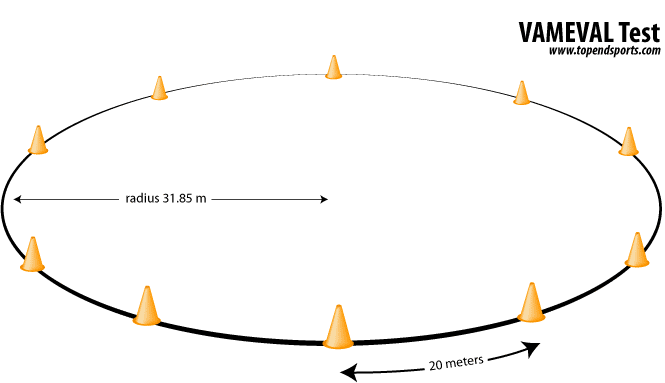The VAMEVAL (VAM-Eval) Test is a running test which can be used to calculate the maximal aerobic speed (Cazorla and Leger, 1993). The test involves running around a track, increasing the pace every minute. The maximal aerobic speed (or maximal running speed) is defined as the slowest speed at which you reach VO2max. This speed is used to help set an appropriate running pace in training programs.
test purpose: The purpose of this test is to calculate the maximal aerobic speed.
equipment required: 200m or 400m circular track, stopwatch, marker cones, VAMEVAL audio track, recording sheets.
pre-test: Explain the test procedures to the subject. Perform screening of health risks and obtain informed consent. Prepare forms and record basic information such as age, height, body weight, gender, test conditions. Measure and mark out the course using cones. Perform a thorough warm-up. See more details of pre-test procedures.
test setup: the test can be completed on a 200m or 400m oval or round track. You can create a 200m circle using a tape measure from a central point (radius 31.85m). Place cones every 20 meters around the track. You can start one player on each cone (up to 10 players at once on a 200m track).

procedure: The participants run around a track with markers placed every 20 meters. The test begins at 8km/hr and the pace increases by 0.5km/hr every minute. Each player must maintain the correct speed as indicated by the audio recording, so that they are in line with a marker cone when each pacing signal sounds. If a player is one meter or more behind the required pace, they receive a warning. If they are more than two meters behind, they have reached the end of the test and their result is recorded.
scoring: the maximal aerobic speed (VMA) of the last shuttle achieved is recorded. The maximal oxygen consumption (VO2max) is estimated by the formula: VO2max (ml/min/kg) = 3.5*VMA (Km/h).
variations: The starting speed can vary depending on the fitness of the subject group. Guessogo et al. (2018) have proposed a reduced area version conducted on a 20m square area, which may be useful if the larger space is not available. You can also conduct this test on a treadmill, where the gradient should be set at 1% to simulate flat outdoor running.
advantages: Groups of athletes can be tested at once, and it is a very cheap and simple test to perform. As the test is conducted on a circular running track, all the athletes will be in view throughout the test.
references:
- Cazorla G, Léger LA. Comment évaluer et développer vos capacités aérobies? Epreuves de course navette et épreuve VAM-Eval. Eds AREAPS. 1993. 123
- Guessogo WR, Ebal ME, Mbouh S, Assomo NPB, Azabji KM, Mekoulou NJ, Fouda ONAL, Mbang BW, Mandengue SH, Temfemo A. The 20 m2 VAMEVAL Test: A Reduced Space Approach to Determine the Maximum Oxygen Consumption of Young Cameroonians. International Journal of Sports Science and Physical Education. Vol. 3, No. 2, 2018, pp. 27-31.
Similar Tests
- University of Montreal Track Test — the original beep test, though run continuously around a track.
Related Pages
- About measuring Maximal Aerobic Speed (MAS)
- General Walk or Run Test
- Other aerobic tests
- All fitness test list


 Current Events
Current Events